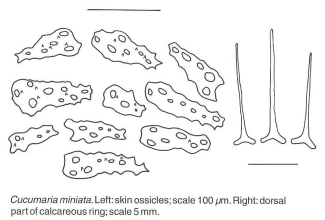miniata = bright red
|
Cucumaria miniata exhibits typical suspension-feeding behaviour. Feeding tentacles withdraw rapidly when touched. C. miniata feeds very little from November to March, when the plankton is reduced. Most specimens lie hidden beneath the rocks. The posterior end protrudes from beneath the rock to fill the respiratory trees with freshly oxygenated water.
Spawning is from early March to mid May, during intervals of slack tide. The anterior part of the body extends and green eggs (mean diameter 520 mm) are released in buoyant pellets which later fall apart. The yolky egg develops into a sluggish, non-feeding larva. Juveniles settle onto the undersides of rocks near the adults.
Predators of Cucumaria miniata include the Sand Star (Luidia foliolata), the Northern Sun Star (Solaster endeca) and the Sun Star (Solaster stimpsoni). The latter causes C. miniata to react with violent contractions in an effort to escape. The Kelp Greenling nips off the tentacles of this sea cucumber.
Like vertebrates, Cucumaria miniata uses haemoglobin to absorb and transport oxygen to the cells. The blood cells of C. miniata also show many structural similarities to the blood cells of some lower vertebrates such as trout and hagfish.
Some specimens of Cucumaria miniata contain a parasitic gastropod, Thyonicola dogieli. This parasite appears as a long egg-filled tube that is coiled like a spring.
|
|
